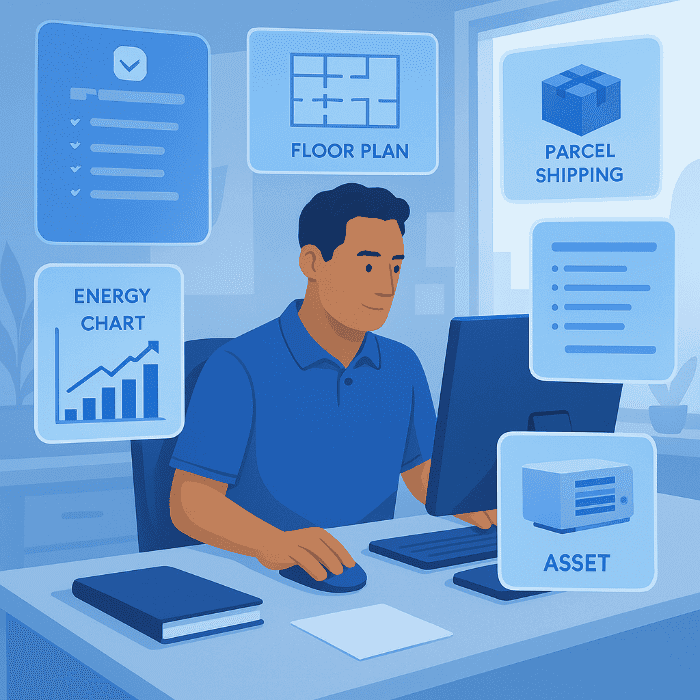Managing a hybrid office means juggling tasks, schedules, communication, space bookings, and even shipments. The right office management software helps with all of these.
In this post, we review the 12 best office management software across several categories: project/task tracking, team chat, employee scheduling, AI meeting assistants, space booking, and shipping logistics.
We compare leading office management solutions for 2026 and explain how each fits into your digital workplace toolkit. The goal is to help you select a combination of software that matches your team’s needs and scales with your business.
Quick Comparison of Leading Office Management Solutions
Here’s a high-level table to help you compare major tools by category, value proposition, and pricing model:
| Category / Primary Use | Brief Description | Free Plan or Subscription Required |
|---|---|---|
| Project & Task Management | Tools for organizing projects, tasks, timelines (Kanban, Gantt, to-do lists). Examples: ClickUp, Asana, Notion. | Free plans available: ClickUp and Asana each offer free tiers (basic features, user limits); Notion has a free personal plan. Upgrades unlock more collaboration and storage. |
| Team Communication & Collaboration | Chat and conferencing for team collaboration. Examples: Slack, Discord. | Free plans available: Slack’s free tier (limited message history) and Discord’s fully free plan (with optional paid Nitro) cover basic chat and calls. Paid plans add advanced features. |
| Employee Scheduling & Time Tracking | Shift scheduling, time clocks, and basic HR tools. Examples: HomeBase, Connecteam. | Free plans available: HomeBase’s free “Basic” plan covers scheduling/time tracking for up to 20 employees. Connecteam offers a free plan for up to 10 users. Paid tiers provide advanced HR integrations. |
| Office Parcel Shipping Management | Centralized carrier/vendor accounts, tracking, and spend control. Example: Airpals. | Free tier covers Same-Day and Multi-Carrier shipping. Scale up for parcel analytics and enterprise tools. |
| Room Booking & Visitor Management | Meeting room and desk scheduling; visitor check-in. Examples: Robin, Envoy. | Mostly paid: Robin is an enterprise solution (no free tier, contact for pricing). Envoy’s basic visitor check-in is free for small workplaces; desk/room booking features come in paid plans. |
| AI‑Powered Meeting Recording | Auto-transcription and AI summaries of virtual meetings. Examples: Read AI, Granola. | Free limited plans: Read AI offers 5 free meetings/month. Granola has a free tier (25 limited transcripts). Advanced features (unlimited transcripts, integrations) require subscription. |
This comparison should help you identify which category (and tool) fits your needs at a glance. Next, we dive deeper into each category.
Which Office Management Tools Should You Use in 2026?
Not every company needs the same set of tools. Some prioritize project coordination while others need a better way to handle visitors. In this section, we examine each category, highlighting top platforms and what makes them shine.
Project & Task Management (ClickUp, Asana, Notion)
For project management, you need tools that let teams plan tasks, set deadlines, and visualize progress.
- ClickUp: An all-in-one office management tool that supports to-do lists, Kanban boards, Gantt charts, calendars, and more. ClickUp is highly customizable and integrates with over 1,000 apps. It even has AI features (chat view, AI-generated task details) that reviewers praise as “setting ClickUp apart”.
- Asana: Known for its simplicity, Asana makes project tracking easy with drag-and-drop lists, boards, and timelines. It’s an intuitive and user-friendly office management tool with a clear interface, letting teams organize tasks without steep learning curves.
- Notion: A flexible workspace that combines docs, databases, wikis, and kanban boards in one platform. Unlike traditional project tools, Notion can replace multiple apps; you can build project trackers, knowledge bases, CRM tables, and more within custom pages. It enables teams to collaborate in real-time, with updates syncing instantly across all pages.
Team Communication & Collaboration (Slack, Discord)
Effective communication lies at the core of every office management solution:
- Slack uses channels to separate projects or departments. Its deep app ecosystem connects with tools like Asana and Google Drive. Free plans limit searchable history but allow unlimited users. Paid plans expand archives, add compliance features, and support voice/video calls.
- Discord offers persistent chat rooms and high‑quality voice channels. Originally built for gaming, it now hosts communities and business teams alike. Discord provides unlimited message history and server customization for free; paid Nitro subscriptions enhance media quality but aren’t essential for collaboration. Select Slack if you need enterprise-grade integrations and security; choose Discord when you value casual communication with built-in voice chat.
Employee Scheduling (HomeBase, Connecteam)
Manual scheduling can consume hours each week. Employee scheduling tools solve this by automating shift creation, communication, and tracking.
- HomeBase allows managers to create schedules, share them instantly, and track time. Employees receive shift reminders and can request swaps. While the core scheduler is free, premium versions integrate with payroll and offer labor cost forecasting.
- Connecteam is built for mobile workforces. Its scheduling features include drag-and-drop shift planning, open shift publishing, and PTO requests. Connecteam also has built-in chat and employee directories, making it a light intranet. It's free plan supports up to 10 users, and paid tiers add features like geofencing and API access.
Office Parcel Shipping Management (Airpals)
Now, let’s talk about office shipments. In a hybrid world, managing packages to and from the office can be a logistics headache. Airpals steps in as a specialized parcel management platform. Instead of employees using personal FedEx/UPS accounts and chasing down tracking emails, Airpals consolidates everything in one interface: Key capabilities of Airpals include:
- Carrier account consolidation: Manage FedEx, UPS, and USPS from a single dashboard.
- Spend visibility: Track shipping costs across teams, departments, or offices.
- Policy controls: Set service preferences, approval flows, and spending limits.
- Audit-ready reporting: Export data for finance teams, budget reviews, or compliance audits.
- Chain of custody: Capture delivery confirmations and proof of handoff for high-value or sensitive items.
- Flexible plans: Use core services with a standard account or unlock advanced features through enterprise options.
Explore how Airpals fits into your office management workflow to keep logistics as organized as every other part of your workplace operations.
AI‑Powered Meeting Recording (Read AI, Granola)
The next category addresses a very modern need: automated meeting notes and analytics. Two cutting-edge tools:
- Read AI: An AI meeting copilot that integrates with Zoom, Google Meet, and Teams. During a meeting, Read transcribes speech in real time and highlights key points. After the call, it generates summaries with action items, decisions, and follow-ups. Read AI even offers an AI-powered search that scans across your past meetings and emails to answer questions instantly.
- Granola: A minimalistic “AI notepad” designed to capture human and AI notes together. Unlike other tools, Granola doesn’t need to join your calls; it works quietly in the background, letting you take notes while it enhances them with AI context and summaries afterward. The result is clean, well-structured notes that blend your input with intelligent highlights.
Room Booking & Visitor Management (Robin, Envoy)
Managing shared office spaces and visitors is another office challenge. Two key solutions:
- Robin: A comprehensive office scheduling and space management system. Robin offers features like room and desk booking, group scheduling, and a real-time interactive map of your office. Robin integrates with Outlook and Google calendars for seamless booking. A smart complement to digital office management systems.
- Envoy: A workplace platform that streamlines visitor management and desk booking. Through an intuitive kiosk system, guests can check in, sign documents, and notify hosts instantly. Its workspace tools also make it easy for teams to reserve desks or meeting rooms and monitor space usage in real time. Envoy offers a free plan for basic check-ins, while advanced features like analytics, floor plans, and custom policies are part of its paid tiers.
How to Choose the Best Office Management Software
Choosing the best office software involves more than comparing features. Use these criteria to build the right stack of tools:
- Define your priorities: Identify the pain points that slow your team down. Do you need better task organization, improved communication, automated scheduling, or a more efficient parcel shipping process? If parcels are part of daily operations, consider adding a parcel management software, like Airpals, to centralize carriers and visibility.
- Check integrations: Choose platforms that connect with your existing systems. Integrations reduce context switching and enable automation.
- Evaluate pricing: Start with free tiers or trials. Once you understand your usage patterns, compare the cost of moving to paid plans across multiple tools.
- Consider scalability: Ensure the tool can accommodate more users and features as your company grows. Pay attention to security certifications and data privacy policies.
- Prioritize ease of use: A great tool is worthless if your team won’t adopt it. Look for intuitive interfaces and robust support resources.
Following these steps will help you assemble a suite of office management software that enhances productivity rather than adding complexity.
Key Takeaways
- No one tool fits all: We’ve grouped the Top 12 office management software by function. Pick the category (or categories) that match your biggest needs.
- Free vs Paid: Many tools have free tiers (ClickUp, Slack, HomeBase, Connecteam, Granola, etc.) that are useful for small teams or trials.
- Project Management: ClickUp, Asana, and Notion are among the best office management software for tasks and projects.
- Team Chat: Slack (enterprise) and Discord (free-casual) dominate collaboration chat.
- Scheduling: For hourly teams, HomeBase and Connecteam shine. Both let you post shifts and track hours via mobile.
- Parcel Shipping: Don't underestimate logistics. Airpals streamlines parcel shipping operations across multiple carriers and couriers, providing teams with complete visibility and cost control, transforming logistics into an organized, data-driven process instead of a back-office burden.
- AI Meeting Notes: Tools like Read AI and Granola use AI to transcribe and summarize calls.
- Space & Visitors: Manage desks and visitors with Robin and Envoy. Robin provides office maps and booking for rooms and desks. Envoy offers a slick sign-in kiosk and hot-desking.
Conclusion: Bring Your Office Operations Together with Airpals
In a connected workplace, every office management tool should work together to create seamless operations. Once your office management system covers projects, communication, and scheduling, integrating a parcel management solution like Airpals completes the workflow.
By centralizing carrier accounts, tracking, and billing, Airpals helps offices streamline parcel shipping, reduce administrative time, and bring clarity to operational spend.
Request a diagnostic call to see how Airpals can help you optimize your office management workflow and cut hidden shipping costs across your organization.

Frequently Asked Questions (FAQs)
What is an office management software?
Office management software is a collection of digital and cloud-based applications designed to handle the daily operations of an office. From project tracking and communication to visitor management and parcel shipping, these systems reduce manual work and keep workplace processes organized and efficient.
What software do most offices use?
Most offices use a combination of office management systems depending on their needs. Common examples include project management tools like Asana or ClickUp, communication platforms like Slack, and parcel management software like Airpals to handle shipping.
What is the difference between office management and office automation software?
Office automation software focuses on automating repetitive tasks (like scheduling or data entry), while office management systems provide a broader framework that connects people, projects, and operations.
Why do businesses need office management solutions?
Companies adopt office management solutions to increase transparency, improve coordination, and eliminate inefficiencies in everyday tasks. From project planning to parcel shipping and communication, these tools form the backbone of a modern, organized workplace.
What makes Airpals part of the best office management software?
Airpals adds logistics control to your office management system by centralizing carrier and courier accounts, tracking parcel spend, and providing audit-ready visibility. It helps teams manage shipments efficiently while reducing administrative work and hidden costs.




